There’s just something about begonias that brings a smile to your face and a touch of elegance to any garden, indoors or out. These vibrant, blooming beauties seem to whisper, “Hey, sunshine’s overrated: we’ve got your back.”
For those shady spots that need a pop of color, begonias are your go-to pals. Who knew a little shade could create such a stunning display?
Here you’ll find a diverse range of colors, shapes, and sizes to suit your gardening desires. And don’t worry, we’ll debunk the myth that these plants are high-maintenance drama queens. In fact, you’ll soon discover that begonias can be your easy-going companions, too.
So, if you’re craving a touch of pizzazz while embracing the shadows, you’ve come to the right place. Read on to find out everything you need to know about begonia care: from growing to encouraging them to show off their fabulous flowers (and leaves!).
Table of Contents
Begonia Plant Care Guide
History, habitat, and characteristics
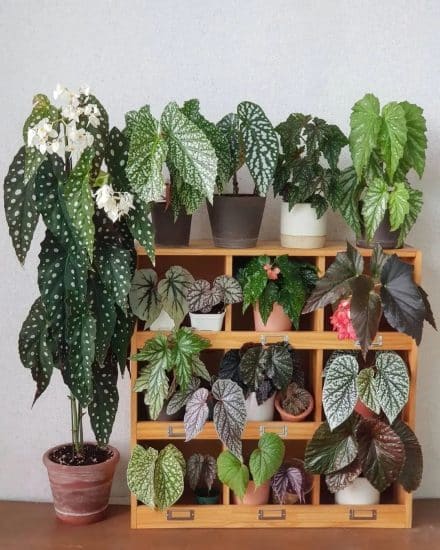
Imagine having over 1,000 siblings, each with their own unique style and personality. That’s exactly what it’s like for the begonia family! Native to the tropical regions of Central and South America, begonias come in all sorts of captivating shapes, colors, and sizes.
They’ve been charming gardeners for centuries, and it’s easy to see why.
You’d be hard-pressed to find a plant lover who doesn’t adore begonias, and it’s not just because they’re downright gorgeous. With a rich history that dates back to the 17th century, begonias have quite the tale to tell. Discovered by French botanist Charles Plumier, they were named in honor of his good friend and fellow plant enthusiast, Michel Bégon.
Fun fact: Begonias are monoecious plants, meaning they have separate male and female flowers on the same plant. So, if you’re feeling adventurous, you could even play matchmaker and create your very own begonia hybrid!
Varieties
Begonia varieties come in a mesmerizing range of colors, shapes, and sizes to choose from. Among the most commonly grown begonias are: Rex begonia, Angel Wing begonia, tuberous begonia, and wax begonias.
Typically begonias can be separated into two groups: foliage begonias and flowering begonias. The names give a pretty good indication of the differences.
Foliage begonias:
- Begonia Rex (full guide)
- Angel Wing Begonia (full guide)
- Polka Dot Begonia (Begonia maculata, full guide)
Flowering begonias:
- Wax begonias
- Tuberous begonia
Rex Begonias
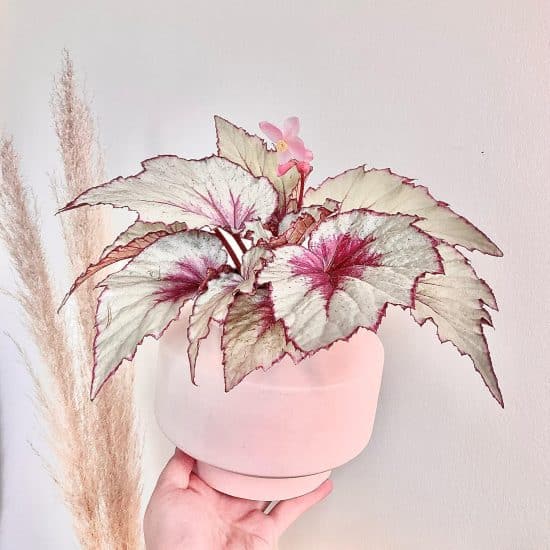
The showstoppers of the begonia world, Rex begonias, are known for their striking foliage that comes in a kaleidoscope of deep greens, rich burgundies, and shimmering silvers. Their elaborate leaf patterns and textures are elegant and opulent at once.
Angel Wing Begonia (Cane Begonia)
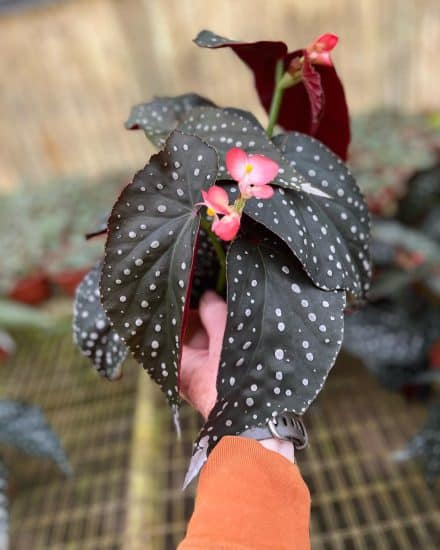
Aptly named for their stylish, bamboo-like stems and angelic, wing-shaped leaves, cane begonias bring a graceful, vertical presence to any space. Angel Wing begonia plants are known for their speckled or variegated foliage and pendulous flowers.
Polka Dot begonia
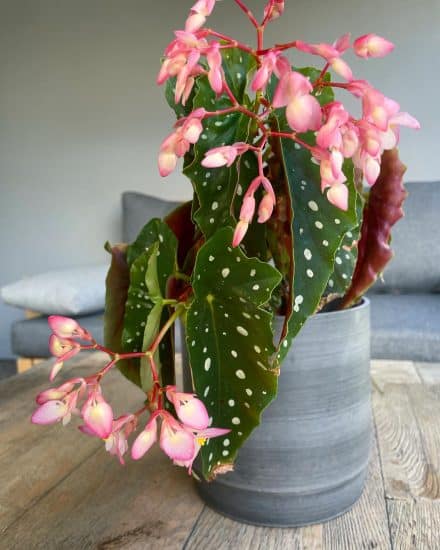
Often compared with cane begonias due to their similar growth habits and appearance, Begonia maculata is a beautiful and eye-catching indoor plant, known for its foliage. The leaves are dark green with white polka dots and a distinctive red undersurface, which gives it an attractive and dramatic look. They can flower (with the right fertilizer), and produce lovely white-through-pink blooms.
Tuberous Begonias
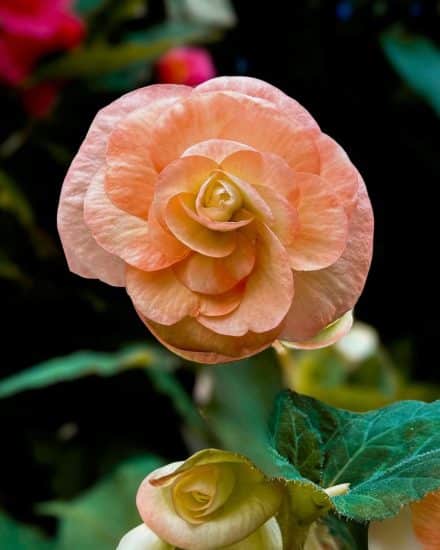
Oh-so-romantic with their lush, large, rose-like blooms in myriad colors (yellow flowers? Yes, please!), tuberous begonias make fantastic outdoor additions to gardens, containers, and hanging baskets. They love filtered sunlight and regular feeding in partial shade to ensure a spectacular floral display.
Tuberous begonias are flowering begonias, and you’ll see some specialized keywords regarding their types. Among the tuberous types, there are “double flowers,” which are hybrids bred to have double the petals and a fuller look. You’ll also see “non-stops,” which doesn’t mean they bloom year-round. Instead, they too have additional flowers, but they’re typically a bit smaller.
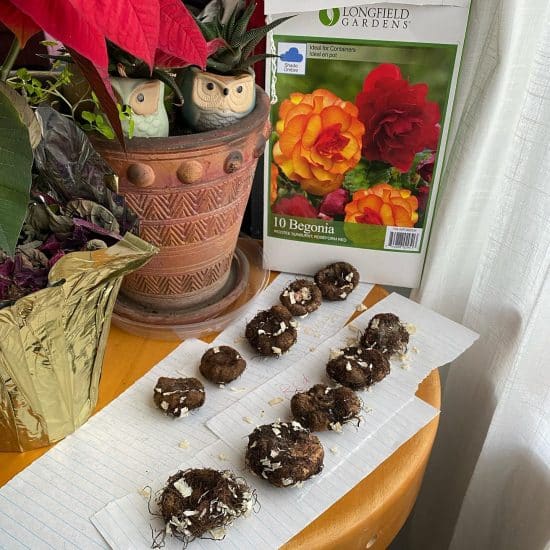
Tuberous begonias will die off in the winter when planted outside, so you’ll have an opportunity to replant their tubers (bulbs) in early spring.
Wax Begonias (Semperflorens)
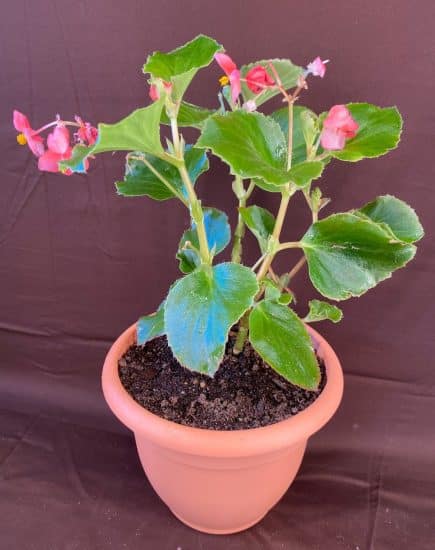
Wax begonias, also known as Begonia semperflorens, are the definition of low-maintenance charm. With their rounded, waxy leaves and cute, continuous blooms in shades of white, pink, or red flowers, they’re perfect for garden borders, containers, or even indoor pots.
Okay, let’s get right into taking care of begonias indoors and everything you’ll need to know. If you do plant and grow begonias outdoors, we’ll give some advice at the end.
Light
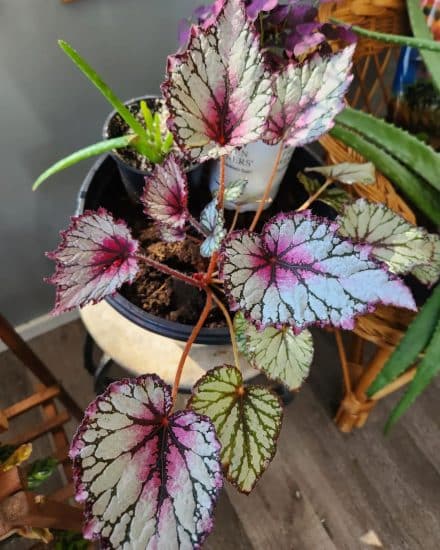
When grown indoors, figuring out the right lighting conditions for your begonias might feel a bit tricky, but don’t worry. In this section, you’ll learn how to create the perfect lighting environment for your begonia plants.
Begonias absolutely adore bright, indirect light. Place them in a partial shade spot, like near an east- or west-facing window with a see-through curtain that diffuses sunlight. Keep an eye on your begonias, though, as too much direct sun can cause their delicate leaves to burn or become crispy (not a good look!).
If your begonia isn’t getting enough light, you might notice leggy growth and smaller-than-usual leaves. But if your plant is exposed to too much direct sunlight, the leaves may turn burnt or crisp and lose their vibrant color (this is a cue to adjust their lighting conditions).
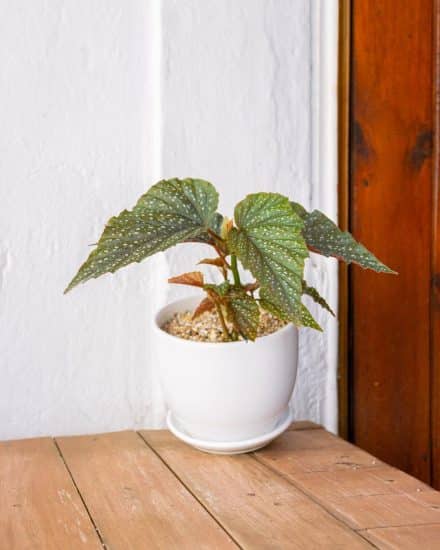
Lighting tips:
- Plant begonias in partial shade near an east or west-facing window with a sheer curtain. This setup provides just the right amount of bright, filtered light.
- Can’t provide enough natural light? No problem! Consider using an artificial light source, like an LED grow light.
Water
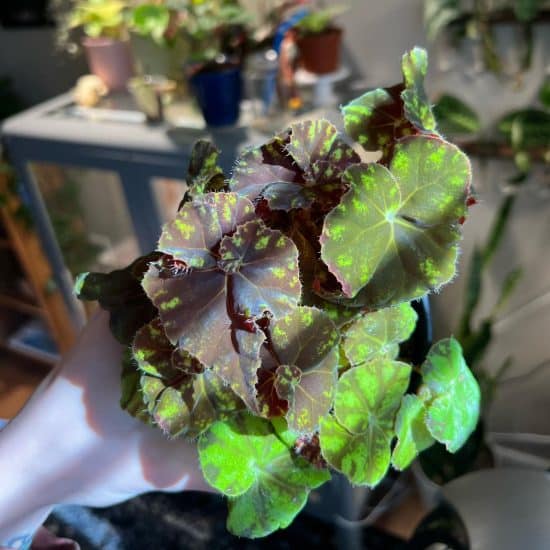
These adaptable tropical plants prefer consistently moist soil, but they can also adjust to more drought-tolerant conditions. Let’s explore the indoor water requirements for growing begonias indoors and the signs of both underwatering and overwatering.
If you use a moisture meter, you’ll want to aim for a level of around 3 to keep your begonias happy. They generally prefer to be under-watered, as too much water causes fungal diseases and weakens the plant to pests.
They also don’t like to sit in waterlogged soil, so make sure you choose a pot with drainage holes so that excess water can easily drain away.
Temperature and humidity
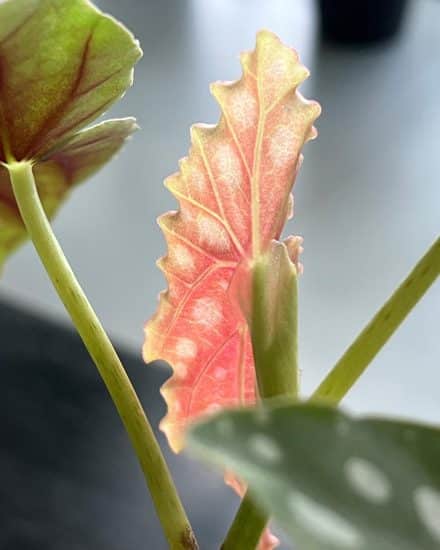
Growing begonias successfully in cooler climates requires finding the right balance of temperature and humidity. Maintaining these conditions will result in thriving begonias with vibrant colors and healthy growth.
Begonias, including tuberous begonias and begonia rex, thrive in warmer temperatures, ranging from 65 to 85 degrees Fahrenheit. Keep your plants in a comfortably warm environment, but be cautious not to let them overheat.
Watch for signs of temperature stress, such as wilting or drooping leaves. Avoid placing your begonias near windows or doors with cold drafts, as exposure to cooler temperatures can cause damage.
Begonias appreciate humidity levels of 45% and above. Low humidity may cause the edges or tips of the leaves to turn brown. Excessive humidity can lead to bacterial and fungal problems, like leaf spot.
To prevent this, keep moisture off the foliage and use a fan for added air circulation. Instead of misting, consider using a humidifier or placing a tray of water and pebbles beneath the plant to increase humidity levels.
Temperature and humidity tips:
- Keep your begonias in a temperature range between 65-85°F, away from windows and drafty doorways.
- Maintain humidity levels of 45% and above for optimal growth.
- Avoid misting or grouping plants too tightly.
- If you do see moisture accumulating on leaves, wipe them off gently, which also helps remove potential pests.
Soil and Planting
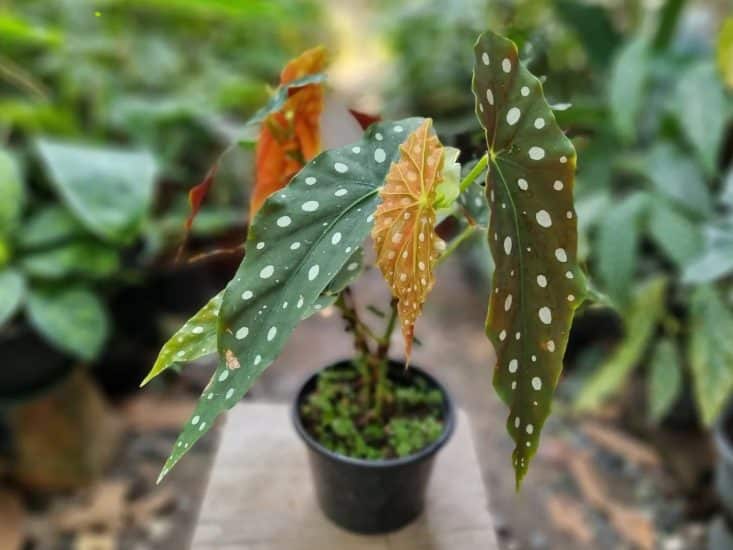
Begonias love a slightly damp soil mixture that retains moisture, but also don’t want soggy soil. We’ll want to use regular potting soil with added perlite, around 20-30%.
If the soil mix is off, you might notice yellowing leaves, which could indicate the soil isn’t draining quickly enough or lacks essential nutrients. Similarly, wilting leaves and slow growth both indicate soil issues.
Both Rex and rhizomatous begonias favor being root-bound. This is actually very fortunate because it means we can give these young plants time to outgrow their pots. Keep them in the nursery pot they arrived in and really let those roots explore the soil so they can pull out that moisture.
Begonias do like fertilizer, especially when you see active growth, but . . . go gentle, and no more than twice a month using a heavily diluted balanced liquid fertilizer. 25-50% monthly is a good place to start.
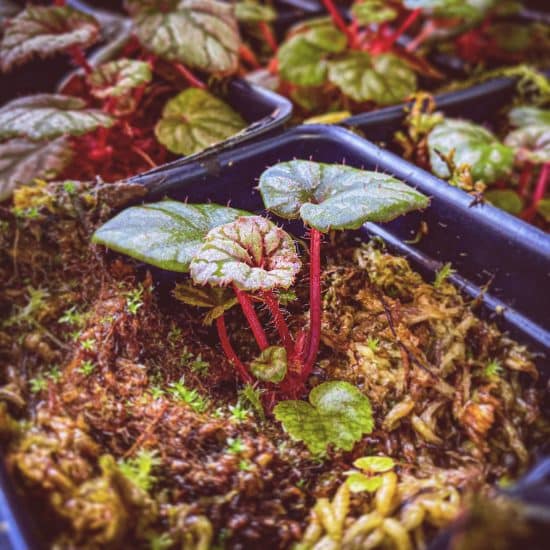
Over-fertilizing your begonia can cause a range of problems. The most common symptoms of too much fertilizer are leaf tip burn, yellowing foliage, and poor growth. In some cases, excess fertilizer may damage the roots.
To resolve these issues, immediately stop fertilizing and flush the soil thoroughly with water to remove excess fertilizer salts. Only resume fertilizing with a heavily diluted solution once your begonia has recovered. Remember, it’s crucial to fertilize your begonia gently and infrequently —not more than twice a month.
As far as where to plant begonias: you have some options. For potted begonias, we love window boxes and hanging baskets. If you have bedding begonias, they’re great to use as a fill outside.
Propagation guide
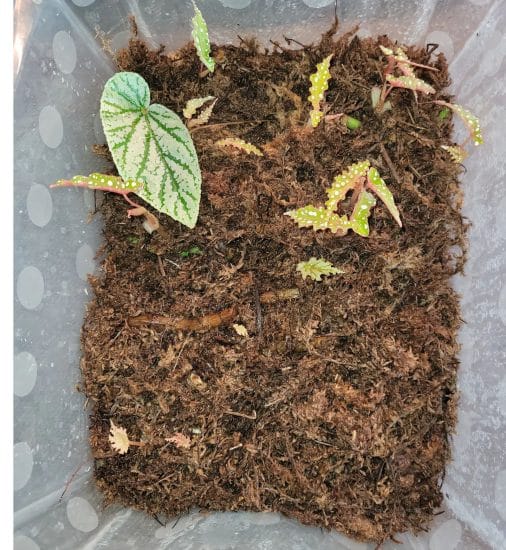
Propagating begonias is super easy! We’ll guide you through the process using stem cuttings (leaf cuttings work, too).
Propagating begonias via stem cutting:
- Start by picking a healthy, happy stem or leaf from your begonia plant. It should be about 4-6 inches long and have a couple of vibrant leaves on top. Use sterilized gardening shears to make a clean cut just below a leaf node.
- After your cutting is ready, let the cut end chill for an hour or so to callus over. This tiny break helps prevent fungal issues once it takes a dip.
- Get a small container filled with filtered water and pop your cutting in. Make sure to remove any leaves that would be taking a plunge; no soggy leaves, please! Refresh the water every week to keep things fresh.
- Find a nice, bright spot for your cutting with indirect light (you don’t want to fry it!). Over the next couple of weeks, keep an eye out for those healthy white roots stretching to about two inches or longer.
- Transfer your cutting to a pot, and make sure the new roots are snug and covered. Keep the soil moist – not soaking – and your cutting will settle in fast.
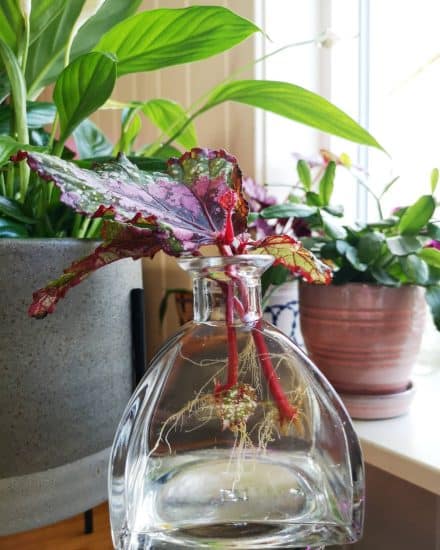
Propagation tips:
- Propagate when begonias are in their prime: Spring and early summer are perfect for giving your plant babies the best start in life.
- Sharing is caring, but not for begonia cuttings: If you’re taking on multiple cuttings, give them each their own space in separate containers or leave enough room in a shared container to avoid a crowded situation.
- Humidity is your new best friend: Keep your newly potted begonia cutting in high humidity for the first few weeks, and it’ll be well on its way to thriving in its new environment.
Common Issues
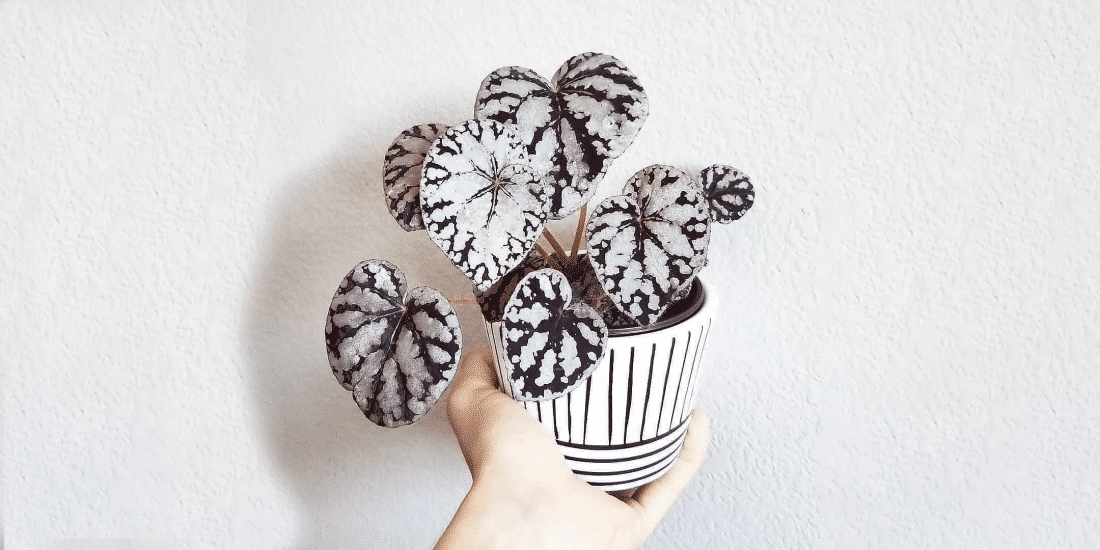
Knowing how to grow begonias is one thing, but just like kids, even when they’re all grown up, we as plant parents are still responsible. We’ll cover the two common issues we see the most (in begonia plants, not our kids): leaf loss and yellow leaves.
Leaf loss
Begonias (even those fancy Rex begonias and tuberous begonias) can be quite sensitive to changes in their environment, and who can blame them? One issue that might pop up is leaf loss, which can be caused by sudden changes in temperature, humidity, or lighting conditions.
To help your begonia bounce back, maintain consistent conditions by avoiding sudden changes in its environment. Keep it in a stable location, and keep an eye on temperature and humidity levels to make sure they stay steady. As your begonia settles in, it should recover and sprout new, healthy leaves.
One more thing to keep in mind . . . Begonias can be a bit temperamental when moved to new surroundings. So, as much as possible, avoid moving your plants, including begonia semperflorens and foliage begonias, after they’ve acclimated to their environment. They might struggle a bit at first, but with some patience and care, they’ll adapt and start thriving again.
Yellowing leaves
To identify yellow leaves, look for a change in color from dark green to yellow, usually on older leaves. One likely culprit behind this issue could be overwatering. To fix this, keep tabs on your watering schedule and make sure the soil around new plant isn’t constantly damp. Let the top few inches of soil dry out between waterings, and your begonia’s roots will thank you.
Another possible cause of yellowing leaves is not enough light. Begonias love basking in bright, indirect sunlight. If your plant isn’t getting enough of those precious rays, try moving it to a spot with better lighting.
Just be careful not to expose your begonia to harsh sunlight, as this can scorch the leaves and cause more harm than good. Trust us on this one.
Pests and diseases
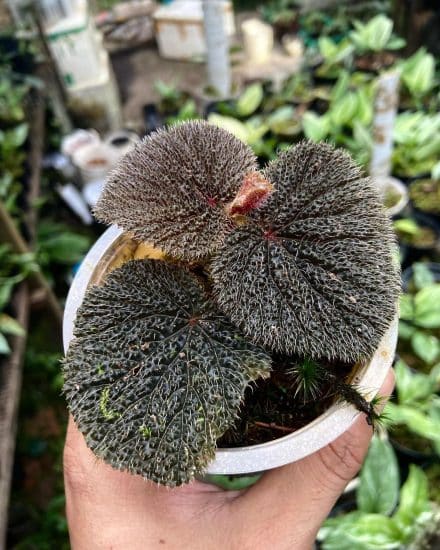
Begonias make such lovely and versatile houseplants, bringing color and texture to any indoor space, from tuberous begonias with their large yellow flowers to the dark green foliage of, you guessed it, foliage begonias.
However, like all good things, they can run into a few issues. So, let’s chat about how to spot these problems, fix them, and keep them from bugging your begonia again!
Root rot
As much as you might try to avoid it, the dreaded root rot can sneak up on begonias as well. If the soil stays wet for too long, we’re left with roots that can’t breathe, leading to rot.
To catch root rot in action, watch for yellowing, wilting leaves, a funky smell, and nasty, mushy, black roots when you pull your begonia out of its pot.
Solution: Carefully remove your begonia from the pot and give those sickly roots a good trim. Scrub your pot with love and fill it with well-draining soil, like a mix containing perlite, pumice, or coco coir. Hold off on watering until the soil dries out a bit.
To keep root rot at bay, remember this mantra: water only when the top inch of soil is dry, ditch the standing water, and make sure drainage is on point. Pop your begonia in a pot with drainage holes and opt for well-aerated soil.
It’s fine if the soil retains moisture (in fact, it should keep some) but you just don’t want it to remain soaking (especially the soil surface) for too long.
Pests
Begonias can become a hangout spot for some unwelcome guests like mealybugs, aphids, and spider mites. These tiny troublemakers might leave your plant discolored, wilting, or worse.
Keep an eye out for small white or brown bugs, webbing, or sticky residue on leaves and stems – these are telltale signs of a pest problem.
Solution: Immediately separate your plant from its buddies to avoid spreading those pesky bugs. Use a damp cloth to wipe down the leaves and stems, sweeping away as many pests as possible. If it’s a more serious infestation, consider breaking out the insecticidal soap or neem oil (just follow the instructions on the label).
Regularly inspect your begonia’s leaves and stems for any signs of freeloaders. Maintain proper air circulation around your plants and resist misting (trust me, lingering moisture on leaves can lead to all sorts of fungal and bacterial issues).
And, of course, keep your begonia happy and healthy with the right light, water, and fertilizer – a strong plant is less likely to fall victim to pests.
Conclusion
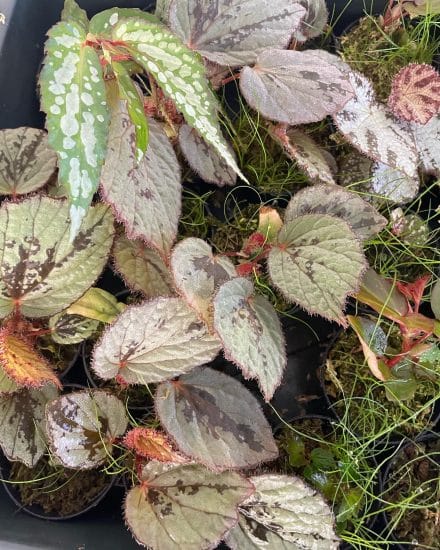
That’s a wrap on our begonia care and growing guide! We hope you enjoyed learning about the captivating world of Rex and cane begonias and feel confident in caring for these stunning plants.
Begonia care summary:
- Provide bright, indirect light and avoid exposure to direct sunlight.
- Keep the soil consistently moist, but never soggy to prevent root rot.
- Maintain temperatures between 65-85°F and humidity levels above 45%.
- Use well-draining soil and pots with drainage holes, and fertilize gently and infrequently.
- Observe your begonias for any signs of stress or pests, and address any issues as they arise.
We hope this guide was helpful and inspires you to add a begonia (or two) to your indoor garden! And, as always, if you have any questions or want to share your begonia success stories, feel free to reach out and connect with us.
Take care, and happy gardening!
FAQ
Do begonias like sun or shade?
Begonias are tropical darlings that appreciate a mix of sun and shade. They crave bright, indirect light but shy away from direct sunlight, which can be harsh on their delicate leaves.
The sweet spot for these beauties is near an east- or west-facing window, ideally with a sheer curtain to gently diffuse direct sunlight. So, let’s say begonias enjoy a little sunbathing in the afternoon shade!
Are begonias indoor or outdoor plants?
Begonias are versatile charmers that can be grown both indoors and outdoors. As houseplants, they bring a touch of tropical paradise to your living space, adorning your home with their vibrant foliage and delicate blooms.
Outdoor begonias are great for adding some pizzazz to your garden, container arrangements, or hanging baskets, where they’ll flourish in dappled sunlight and bright shade.
Are begonias deer resistant?
Great news for those dealing with curious deer in their gardens! Begonias are indeed deer resistant, thanks to their slightly bitter taste. These lovely plants will carry on dazzling your garden, safe and sound from nibbling noses.
What are tender perennials?
Tender perennials are plants that, despite their love for returning year after year, can’t quite stand up to frosty or cool temperatures yet. These sensitive beauties are often treated as annuals in colder climates, but can be brought indoors or overwintered in a protected area to keep their warmth-loving spirits alive.
Can you put begonias in a hanging basket?
Absolutely! Begonias are simply fabulous in a hanging basket, adding a splash of color and charm to any space. Trailing begonias, with their cascading branches and gorgeous blooms, are a popular choice for hanging basket displays.
How do you keep begonias over the winter?
To keep your begonias over the winter, move them indoors if they’re not already houseplants. Once inside, place them near a bright window or under a grow light. Be sure to monitor humidity levels, as begonias relish a bit of extra moisture in the air; consider using a humidifier or a pebble tray with water to maintain optimal humidity.
Keep an eye on temperatures, too — begonias thrive in a pleasant 65-75°F (18-24°C) range. Don’t forget to adjust your watering schedule, as these plants may require less frequent watering in the winter months.


